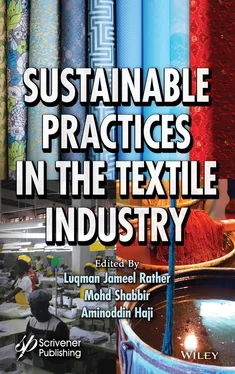Sustainable Practices in the Textile Industry
Здесь есть возможность читать онлайн «Sustainable Practices in the Textile Industry» — ознакомительный отрывок электронной книги совершенно бесплатно, а после прочтения отрывка купить полную версию. В некоторых случаях можно слушать аудио, скачать через торрент в формате fb2 и присутствует краткое содержание. Жанр: unrecognised, на английском языке. Описание произведения, (предисловие) а так же отзывы посетителей доступны на портале библиотеки ЛибКат.
- Название:Sustainable Practices in the Textile Industry
- Автор:
- Жанр:
- Год:неизвестен
- ISBN:нет данных
- Рейтинг книги:5 / 5. Голосов: 1
-
Избранное:Добавить в избранное
- Отзывы:
-
Ваша оценка:
- 100
- 1
- 2
- 3
- 4
- 5
Sustainable Practices in the Textile Industry: краткое содержание, описание и аннотация
Предлагаем к чтению аннотацию, описание, краткое содержание или предисловие (зависит от того, что написал сам автор книги «Sustainable Practices in the Textile Industry»). Если вы не нашли необходимую информацию о книге — напишите в комментариях, мы постараемся отыскать её.
Sustainable Practices in the Textile Industry
Sustainable Practices in the Textile Industry — читать онлайн ознакомительный отрывок
Ниже представлен текст книги, разбитый по страницам. Система сохранения места последней прочитанной страницы, позволяет с удобством читать онлайн бесплатно книгу «Sustainable Practices in the Textile Industry», без необходимости каждый раз заново искать на чём Вы остановились. Поставьте закладку, и сможете в любой момент перейти на страницу, на которой закончили чтение.
Интервал:
Закладка:
2 b) Soaking: Fiber or fabric is soaked for 12 h in tap water to remove the water soluble impurities.
3 c) Scouring: Fibers contain oil and fats on their surface; they are hydrophobic in nature which affects the absorbency of the fibers. The outer hydrophobic layer has to be removed before dyeing. The process by which this water resistance layer is removed from the fabric is called “Scouring”.
4 d) Bleaching: Bleaching is the process of discoloration or removal of natural and other coloring matter from fibers. This is a process of whitening fibers using oxidizing agents.
1.10.2 Mechanism of Dyeing
1 a) Adsorption: Firstly the dye molecules in the dye bath move towards the fiber and those that are nearest to the fiber get “adsorbed” on to the fiber surface. They form a very thin layer of molecules on the surface of fiber.
2 b) Penetration: Secondly the adsorbed dye molecules adhered to the outer surface of fiber gradually penetrate or infiltrate into the pores or canals of the structure.
3 c) Fixation: The final step is one where the dye molecules find suitable locations according to dye size where they get “fixed” or “anchored”.
1.10.3 Process of Dyeing
1 a) Pre-Soaking the Material: Textile stuff, whether it is fabric, yarn or loose fiber is thoroughly wet in water before dyeing begins. Such wetting is achieved by soaking for hours. A thoroughly wet textile dyes well.
2 b) Enzyme Assisted Dyeing: Enzyme assisted dyeing is also performed for textile coloration [58]. Ultrasonic dyeing on cotton and silk fabric is performed with Terminalia arjuna, Punica granatum and Rheum embodi dye. In pretreatment enzyme protease, amylase, diastase and lipase are complexed with tannic acid. Both fabrics showed rapid dye adsorption kinetics and total higher adsorption [59]. Raja and Thilagavathi demonstrated that alkaline protease enzyme process improve the quantity of natural dye exhausted [60].
3 c) Sonicator Assisted Dyeing and Plasma Treatment: Ultrasonic dyeing technique is also called Sonicator dyeing that improves the penetration of dye in fiber or fabric and increases color strength. It is a rapid dyeing process and can be run under mild conditions and low temperatures. Dyeing of wool fabrics carried out with natural dye “lac” through conventional and ultrasonic techniques [61]. In another study Eclipta leaves were taken as natural dye for cotton fabric using both conventional and sonicator methods. Results revealed that Ultra-sonication method showed higher color strength values [62]. Vankar et al. demonstrated the sonicator dyeing method to improve dye uptake on cotton, silk and wool [63]. Plasma treatment in dyeing is conducted for improving the dye uptake of fabric. It is a surface modification technique that performs before dyeing on textile materials [64]. Low-temperature plasma is widely used in non-destructive surface modification of textiles where a wide range of properties can be obtained. Plasma treatment performed on silk fabric and dyeing done with natural dye extracted from Phytolacca decandra [65]. Plasma treatment was conducted to improve the adhesion of chitosan on cotton fibers. After that the cotton is dyed with natural dye extracted from pomegranate rinds. The results exhibited that plasma treatment can enhance the color strength of the dyed sample [66].
4 d) Printing: Printing on textile in India has been a part of India’s cultural identity for thousands of years [67]. Printing produces more colorful effect on the fabric. Printing is a process where colorful designs are created which can be done by hand or machine. Hand printing is done by two methods viz., block printing and screen printing. Boruah and Kalita revealed that turmeric dye produced various soft and stable natural print on eri silk. Three different mordants alum, stannous chloride and ferrous sulfate were selected for printing [68]. Kavyashree investigated the efficiency of natural dye in screen printing on cotton and silk fabrics. Three natural dyes indigo, madder, and sappanwood were selected for screen printing. The results revealed that these dyes can be considered as the recommendable alternative to harmful synthetic dyes [69]. Jimmy et al., investigated the color resistant material from flour of Colocasia esculenta using Acacia catechu as natural dye for batik technique [70].
5 e) Dyeing Condition
i. Dyeing Condition for Cellulosic Material
Cotton is the most popular textile material. Many researchers have attempted to dye on cotton with the natural dyes. Each fabric performs differently in dye bath on the basis of their chemical structure. Dyeing parameters such as dyeing time, temperature, pH, material liquor ratio, dye and mordant concentration play an important role in dyeing. Several studies standardized the dyeing condition for cotton and reported the results as dyeing temperature, 70–100 °C, dyeing time, 60–120 min, material to liquor ratio, 1:20–1:100, and pH, 10–12 may be required for natural cellulosic material.
Vankar et al . used Eclipta as natural dye for dyeing cotton fabric by conventional and sonicator methods [62]. Teli and Paul attempted to dye cotton fabric with extraction of coffee seed coat. Dyeing was done by pre, meta and post-mordanting methods using various mordants. The results showed that coffee seed extract can develop a range of shades with good fastness properties [71]. In another study only coffee seeds were used for dyeing purposes. Some mordants such as FeSO 4, CuSO 4and SnSO 4were applied for improvement of color strength of cotton fabric [72]. Shanker and Vankar applied dye extracted from Hibiscus mutabilis using 1:40 for M:L ratio on cotton fabric. Dyed cotton fabric exhibited good fastness properties [73]. Dayal et al . isolated dye from Parthenium hysterophorus and employed on cotton fabric. The dyeing done with M:L ratio 1:100 at 95–98 °C for 60 min on dyebath [74]. Indi and Chinta the fruits of Phyllanthus reticulatus utilized for dye extraction and application. Premordanting was done with alum (8%) and tannic acid (4%) at the temperature 80 °C for 60 min. Same treatments were performed for Post mordanting. Dyeing was carried out for 10% shade at 80 °C for 45 min at pH from 3–7 [75]. Vankar and Shanker dyed cotton with aqueous extraction of N. oleander flowers. Mordanting was done with metal salt i.e. FeSO 4, SnCl 2, CuSO 4, SnCl 4, K 2Cr 2O 7and alum at 60 °C for 30 min. Then, dye is applied on cotton while keeping the M:L ratio as 1:30 and pH was set at 4 [76]. A study has been conducted for improvement of washing and light fastness by Mukherjee et al ., where pre mordanting was carried out with aluminum sulfate, zinc sulfate, copper sulfate, magnesium sulfate and sodium dichromate. Dyeing was done with M:L ratio 1:20 at the temperature of 90 °C for 45 min. Natural dyes obtained from Curcuma longa , Butea monosperma , Tagetes erecta and Nyctanethes arbor-tristis were taken for experiment by different researchers [77].
Kulkarni et al . attempted dyeing cotton with natural dyes isolated from Pomegranate peel. Copper sulfate and ferrous sulfate were applied in ratios for mordanting. About 4% dye extraction was applied at 80 °C for 60 min with M:L ratio 1:40 [78]. Srivastava et al . studied the dyeing capability of Lichi peels on cellulosic fabrics. Many experiments were performed to determine the dyeing parameters, such as extraction medium, optimum concentration of dye material, extraction time and concentration of mordants and mordanting methods. One such example revealed that 5 g of dye material with mordant like FeSO 4, alum and tannic acid at 60 °C for 1 h produced good results in dyeing after experimentation [79]. A report by Jain presented that three natural mordants Anar, Arjun and Babul bark were applied on cotton fabric for better results. However, on the other hand colorant extracted from Jamun leaves, bark, bark peel and fruit in pre mordanting method dyed for 60 min at 60 °C temperature gave good results too [80]. Single jersey cotton knitted fabric that has been mordanted with some natural extract like pomegranate peel seeds, pomegranate peel bark and some of Gymnosperm leaves Thuja orientalis and Araucaria excelsa gives significant results at 95 °C temperature for 60 min in exhaust method. Then, dyeing of samples was done with natural dyes extracted from mango seed kernel ( Mangifera indica L.) after above mordanting. The dyeing was carried out at 100 °C temperature for 60 min [81]. In a series of studies eco-friendly garments, inner wears, child clothing and home furnishing materials were prepared by dyeing cotton material with Myrobalan ( T. chebula ) and Turmeric ( C. longa ). Compared to the synthetic dyed cotton fabric, the above dyed fabrics showed excellent results in terms of fastness properties. Herbal Textile is finished entirely with herbal extractions, without using any chemicals [82]. Chandel et al . attempted to extract organic dye from Brassica oleracea Var. botrytis (Cauliflower) and applied it on 100% pure cotton. It revealed that different shades from cauliflower can be prepared using different mordants [83].
Читать дальшеИнтервал:
Закладка:
Похожие книги на «Sustainable Practices in the Textile Industry»
Представляем Вашему вниманию похожие книги на «Sustainable Practices in the Textile Industry» списком для выбора. Мы отобрали схожую по названию и смыслу литературу в надежде предоставить читателям больше вариантов отыскать новые, интересные, ещё непрочитанные произведения.
Обсуждение, отзывы о книге «Sustainable Practices in the Textile Industry» и просто собственные мнения читателей. Оставьте ваши комментарии, напишите, что Вы думаете о произведении, его смысле или главных героях. Укажите что конкретно понравилось, а что нет, и почему Вы так считаете.












